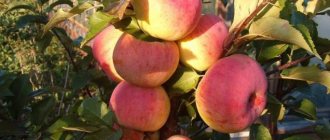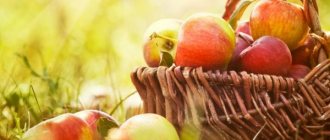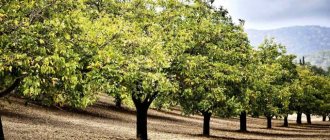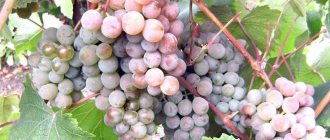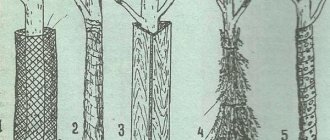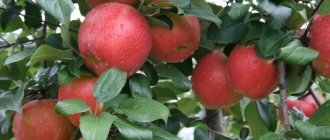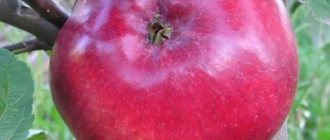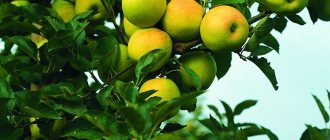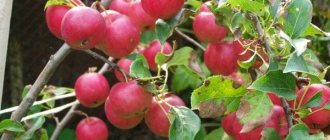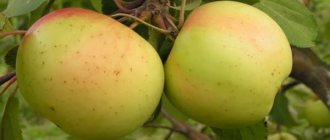Summer residents have always dreamed of picking apples in July, or at least early August. For this purpose, early varieties of apple trees are planted, some of which have been known since Soviet times. It is difficult to say which variety is suitable for a particular gardener. The prepared rating will help you choose the right direction of your search, but the final choice remains with the owner.
Early morning
A relatively new variety, no more than 10 years old. Received as a result of crossing Melba, the oldest American variety, and Red Early. The tree grows small, the crown is compact, dense planting of an apple orchard is possible. The apple tree is early ripening, begins to actively bear fruit in the second year, and bears fruit without interruption.
Description of the tree:
- branches are straight - grow mainly upward;
- shoots are slightly pubescent, thin, covered with brown bark with a green tint;
- the leaves are medium in area, with serrated serrations.
The tree has good regenerative abilities: grafted branches begin to produce apples in the second year; in some years, fruiting was observed on annual shoots.
The apples are almost the same size, round-conical, covered with a smooth red peel. The waxy coating is weak, the skin is thin. The pulp is white when cut, moderately grainy, juicy. The taste is sweet and sour. Average fruit weight is 140-160 g.
The harvest ripens gradually; ripe apples may crumble and lose their presentation.
Earley Geneva
A variety of American origin, obtained in 1964 at the Geneva nursery, hence the name. The tree grows up to 3.5 m in height. On certain rootstocks it can reach large sizes. Growth is rapid in the early years, then slows to an average rate.
Variety characteristics:
- early ripening - the beginning of the third ten days of July in the Krasnodar Territory, late July-early August in the Middle Zone and the Urals;
- fruit weight 90-100 g;
- yield according to the State Register is 152.3 c/ha, per tree up to 50 kg;
- ripening is uneven, the crop is harvested several times per season;
- Scab resistance is average, 20% of trees are affected.
The apple tree has a moderately dense crown of a compact type, for which it is often classified as columnar. The shoots are of medium thickness, extend from the skeletal branches at an acute angle, and are covered with brown bark. The apples are round in shape and there are no signs of rust. The color is green with a slight yellow tint, there is a red blush over almost the entire apple. The pulp is cream-colored, medium in density, tender. The aroma is subtle. The taste is sour, rating 4.5 points.
The apple tree variety is unpretentious in care and tolerates frosts down to -25 °C and heat. It responds to moisture deficiency by reducing the weight of apples. Resistance to diseases is high, with the exception of scab - every fifth tree was affected by the pathogen at the experimental station. Apples cannot be transported - the skin is damaged and the presentation is lost.
Review from Elena, Belgorod region. This variety of early apples is good for everyone: they ripen quickly, do not get sick, and you can do without watering. But one minus kills me: the taste is sour. It will make jam, but I can’t eat it fresh.
Winter apple varieties
Apple varieties with late ripening are called winter apples. The value of these varieties is that such fruits can be stored until the beginning of spring. The best varieties of this category have good keeping quality.
Winter apples are difficult to eat immediately after picking, since they usually ripen during storage. The harvest is harvested from mid-autumn, and the fruits remain until May-June.
Antonovka
A well-known and popular variety. However, there are so many varieties of Antonovka in gardens that it is very difficult to talk about it in detail. There are fruits of different sizes and with varying degrees of shelf life.
The variety is old, but is popular among summer residents.
Antey
Early fruiting variety with winter ripening. The fruits are larger than average. In the phase of consumer maturity, the top color is crimson with a dark burgundy tint and a waxy coating.
The pulp is greenish-yellow, juicy, loose, with a very good sweet and sour taste. The duration of storage of fruits in the basement is 6-7 months.
Bogatyr
Winter variety of apples from the Michurinsky All-Russia Research Institute. The variety is early-bearing and resistant to scab. The trees are tall and have medium winter hardiness.
The fruits of this variety are large, 120-300 g, flat-round in shape. The pulp is white, dense, with a pleasant sweet and sour taste. Apples are hard and strong.
ADVICE! Bogatyr apples are good in baked form - charlottes and apple pies!
Harvesting takes place at the end of September - early October. If stored properly, apples will last until the end of February.
Bolotovskoe
Winter variety of apples, immune to scab. The trees are tall with good winter hardiness and productivity.
The fruits are medium-sized (150 g) slightly flattened. The color of the fruit is green. The pulp of the fruit is greenish, dense, juicy, sweet and sour taste.
Removable fruit maturity occurs in early September. The fruits of the Bolotovskoye variety are stored until mid-February.
Mac
The unique variety McIntosh (Mekintosh) comes from Canada. The trees are medium-sized and begin to bear fruit 6-7 years after planting.
The fruits are quite large with a purple or burgundy outer color and a waxy coating.
The harvest is harvested in late September - early October, after which it lies for 2-3 weeks and only after that is considered ripe. Apples are stored until early spring.
Winter hardiness and scab resistance are average.
Sinap Orlovsky
A variety with fruits of late winter ripening. The trees are quite large, vigorous, and winter-hardy. Fruiting begins 4-5 years from planting.
The fruits are large green with a blush, sweet with a slight sourness.
The harvest is harvested in late September - early October, apples remain until May.
Spartan
Winter variety of Canadian origin. Trees with moderate growth, high early fruiting and good yield. However, the winter hardiness of the plant is low.
Spartan fruits are medium-sized with an intense bright burgundy blush. A strong waxy coating gives a purple color to ripe fruits.
The pulp of apples is white, dense, juicy, sweet, without sour aftertaste, aromatic, of good taste.
Under good conditions, Spartan fruits are stored until mid-April.
Among the advantages are the resistance of the apple tree to scab and the high taste of the fruit.
Sinap Northern
One of the varieties with good winter hardiness and keeping quality of fruits. Apples are stored until May-June. Early-growing variety with abundant harvests.
Average resistance to fungal diseases. Suitable for fresh consumption, processing into juice, compote and jam, as well as for making dried fruits.
Haralson
The variety is low-growing, with brightly colored medium-sized fruits.
The taste of apples is sweet, with slight sourness and slight tartness.
The early fruiting and productivity of the tree are high. Winter hardiness is sufficient.
Chinese gold
One of the oldest varieties of early apple trees in Russia, bred in 1907 by I.V. Michurin by crossing White filling and Kitayka. By modern standards, the crop is not particularly successful - it is easily affected by scab, apples fall off at the slightest wind, and the yield is not encouraging. However, the tree bears fruit for about 70 years and can withstand any winter, which is why it is planted in personal gardens in the Moscow region and the central region.
Main characteristics of the variety:
- the fruits are small, no more than 40 g;
- apple tree height up to 7 m, usually 5 m;
- fruiting in the third year;
- fruit ripening by the end of June;
- yield per tree up to 30 kg.
The variety is zoned for the Northwestern and Volga-Vyatka geographical regions, but there is information about successful cultivation in other regions of the country, with the exception of Siberia.
The apples are small (can be seen from the photo), the color is yellow, the waxy coating is abundant. The ribbing is weakly expressed and absent in most specimens. The peduncle is short. The pulp is cream-colored with a yellow tint, juicy, the aroma is noticeable. The taste is sweet with sourness. It is preferable to use the fruits for processing; they do not last long.
The variety is self-sterile and requires pollination to form ovaries. Moscow pear or White filling apple trees are best suited.
Early varieties of apple trees
First of all, you will pay attention to the summer varieties of apple trees. And there are also early summer ones. Other times, it doesn’t matter that they taste sour. After all, they are the first.
What are their features and differences:
- The harvesting maturity of these apples occurs at the end of July and until mid-August. It is clear that you start eating them earlier;
- And in different climate regions these periods are not the same. Where before? And where and later. But you know this yourself.
Remember!
- The harvest and consumer maturity of these varieties is almost the same;
- Provide for quick processing of early apples or their sale;
- They are not stored for more than 2-3 weeks. And if the fruits are preserved, their qualities have evaporated. They don't like apples and potatoes.
So gardeners are planning to have 1-2 early ripening apple trees on their plot.
These can be varieties:
- Domestic:
- Grown for many years in most regions: White filling;
- Chinese golden early;
- July Chernenko;
- Korobovka;
- Borovinka.
Grushovka Moscow;
- New: Arkadik;
- Kovalenkovskoe;
- Apple saved;
- Silver hoof;
- Wonderful;
- First fireworks;
- Red hill;
- Aboriginal;
- Pavlusha;
- Robin;
- Arcade summer yellow;
- Wine;
- Suislepskoe;
- July Petrova;
- Commemorative;
- Anise is sweet;
- Red early ripening;
- Bel Chernyshevskaya;
- Zhemchuzhnoe;
- Red early;
- Candy;
- Golden summer;
- Lungwort.
And this is not a complete list. There are local varieties and little-known ones.
- Foreign: Well known: Melba;
- Mantet;
- Stark Erliest.
- Earley Geneva;
Lungwort
Among summer apple trees, Lungwort stands apart, favorably differing in taste and disease resistance. The variety is relatively old, bred in the middle of the last century. Parent varieties are Cinnamon Striped and Welsey.
Main characteristics:
- the beginning of fruiting in the 4th year;
- apple weight up to 150 g;
- tree height 5-7 m;
- winter hardiness;
- self-fertility..
The first decade the harvest is annual, then interruptions begin. This problem can be solved by purchasing seedlings on a rootstock, for example, a seed one, which ensures regular fruiting for up to 50 years. From one tree you can collect up to 180 kg of fruit.
The apples are flat-round in shape, the cover color is bright red, the main color is yellow-green. The pulp is dense, light beige in color with pronounced graininess. The taste is sweet, the aroma is specific and pronounced. Apples can be stored for no more than a month; organoleptic properties last for a week or two. Cleaning in the first half of August. The variety tolerates severe frosts and is grown everywhere, right up to the Krasnoyarsk Territory. Resistant to all crop diseases, including scab. The crown requires systematic pruning and shaping.
Review from Victor, Ryazan region. Personally, I don’t have a particularly high opinion of the Medunitsa variety: my apples fall off before they ripen. Although I remember how they grew them in industrial gardens in Soviet times.
White filling
This apple tree is a product of domestic selection; it is the leader in popularity among early fruiting garden crops. High frost resistance and disease resistance make it possible to grow it throughout Russia. White filling is a medium-sized tree with a pyramidal crown; it begins to bear fruit at 4-5 years. The apples are round in shape and yellowish-white in color. The pulp is coarse-grained, juicy, slightly sour in taste. The shelf life is quite short, no more than 3 weeks. White filling is prone to periodic yields; in a good year, up to 200 kg of apples can be harvested from one 10-year-old tree.
Related article:
How to properly graft an apple tree
Good to know: How to graft apple trees
Wonderful
A unique variety in all respects, obtained by Chelyabinsk breeder A.M. Mazunin. It differs from other apple trees in its large crown diameter and tree height, which does not exceed 1.5 m. It belongs to the dwarf self-cresting species.
According to reviews, the fruits ripen in early August, are densely located on the branches and have the following characteristics:
- weight 120-140 g;
- shape - flat-round;
- skin color - yellow-green with a red blush that forms under the rays of the sun;
- taste - sweet and sour with a pleasant aftertaste;
- Shelf life - no more than a month.
The height of a mature tree may vary depending on the rootstock. When using clonal forms, it is possible to grow an apple tree up to 1.5 m in height; seed rootstocks allow the tree to grow up to 2 m.
Active fruiting begins in the third year, but you can understand the true taste of apples from 3-4 years. The yield is high, up to 100-120 kg are harvested from a tree even in the Urals and Siberia. The variety can be grown throughout Russia - winter hardiness is increased. Immunity to scab is high.
Review from Arina, Taganrog. I have been growing the Chudnoye variety for several years. In our conditions it grows well, but it needs watering. We eat, process and dry apples. True, it takes more time to dry due to its high juiciness.
Columnar early apple trees
Early columnar apple tree and Dialogue
Columnar early varieties of apple trees are gaining popularity. Not only are they easy to grow, but in addition, they do not take up much space on the plot, while giving a large harvest!
- “Early columnar apple tree” is a fruitful (5-8 kg/tree), dessert variety. The apples are fragrant, sweet with sourness, yellow in color with a blush. The weight of the fruit is about 120 g. The pulp is creamy and crunches when bitten. The tree is medium-sized, compact. Fruits in August. Frost resistance up to -30 degrees Celsius.
- “Dialogue” is a medium-sized apple tree variety. The apples are yellow, large, slightly flattened. Inside the pulp is juicy and sweet. Has resistance to frost. The yield is large and stable.
- "Medoc" is a semi-dwarf species, growing up to 2.5 meters. Productivity is high. There is resistance to frost, some diseases, and pests. Apples are yellow-white. The peel is dense and thick. The pulp is grainy, sweet (honey) and juicy. Each fruit weighs between 100-250 g.
- "President" is another semi-dwarf variety. Very productive, resistant to frost and some diseases. The apples are fragrant, pale yellow or pale green with a pink blush. Fruit weight is 150-200 g. The pulp is fine-grained, with a high juice content.
Summer varieties of apple trees, despite the short ripening period, produce very tasty, juicy, sweet apples, although the taste directly depends on the variety. And yet, professional gardeners believe that the ripening period does not harm the taste of apples. Such varieties are grown for sale, for personal consumption or canning.
Moskovskaya Grushovka (Skorospelka)
An ancient variety, mentions of which date back to the 18th century. Suitable for the Moscow region and central Russia; it will not bear fruit normally in southern latitudes. It has a pyramidal crown and can reach up to 6 meters in height. With age (over 10 years), due to the growth of lateral branches, the crown becomes spherical.
Has the following qualities:
- fruiting - for 4-5 years;
- ripening - first ten days of August;
- fetal weight - 70-90 g;
- yield per tree - 70-170 kg;
- uneven ripening.
The apples are yellow or lemon, the top color is red, striped. The pulp is loose, with a noticeable yellow tint, pronounced aroma and sweet taste with pleasant sourness. Overripe specimens become mealy and tasteless. The fruits are not processed, only for fresh consumption.
In hot, dry weather, the apple tree may drop its fruits unripe. During prolonged rains it becomes covered with scab. Sanitary pruning is required for this variety.
Melba: gardeners' opinion
In addition to Papirovka and White filling, there are other varieties of early ripening apples that are well known to almost all summer residents. These, for example, include Melba. This popular variety, which has earned many good reviews from gardeners, was bred in Canada in 1889. Its advantages include, first of all, good yield, as well as excellent transportability of fruits (which is rare for early-ripening varieties).
Melba apples also last a very long time. Many gardeners advise picking them when they are green and storing them in the refrigerator. With this storage method, apple fruits of this variety can remain fresh until January.
Melba apples are light green in color with a striped blush. Their sweet pulp has a characteristic coffee aroma. The tree of the Melba variety itself is medium-sized and forms a fairly neat rounded crown. These apple trees enter the fruiting period 4-5 years after planting. Among the positive characteristics of the variety, among other things, summer residents include resistance to scab and the ability to easily tolerate low temperatures.
Quinte
A variety of Canadian origin, valuable for many gardeners, was included in the State Register in 1986, but is now not there. Recommended for planting in gardens of the North Caucasus, Lower Volga region, and central regions of the country. Can be grown in amateur gardens in the Moscow region and Volgograd region.
The tree is medium in size, height does not exceed 4 m. The crown is round in shape, slightly elongated horizontally, the lower branches are directed towards the ground. The annual growth is 4-6 cm.
Description of apples:
- size medium;
- weight up to 150 g, average - 120 g;
- yellow-green color with a slight scarlet blush;
- the pulp is dense, at the time of harvesting it is soft green in color, after a week it is creamy;
- the taste is pleasant, with sourness, the aroma is barely noticeable.
Fruiting in Quinity begins in the fourth year. If the seedling is on a seed rootstock, then in the southern regions fruiting begins in the 9th year. Productivity by 10 years of age reaches 60 kg per tree.
Immunity to powdery mildew is high, to scab is low. In severe winters, resistance to cold decreases; this variety is more suitable for growing in temperate climates. The shelf life of the fruit is low, no more than 10 years. Transportation is poorly tolerated.
The variety is self-sterile and requires pollinators. Papirovka, Vista White, Julired will ideally cope with this role.
Close
This variety is the earliest ripening; its fruits can be tasted already in the second half of June, that is, a couple of weeks earlier than Belyi Nivliv. The tree has medium height and a rounded crown. The apples are red in color, weighing up to 150 g, conical in shape, the flesh is fine-grained, white, juicy. Close begins to bear fruit in 5-6 years, giving high, stable yields. The plant has average winter hardiness and good immunity to diseases.
Related article:
Jonagold apple tree - description and characteristics of the variety
July Chernenko
A universal variety of early apples, intended for gardens in Central Russia. It is characterized by high yield, excellent winter hardiness, and good disease resistance.
The tree is tall, the lower height threshold is 5 meters, rarely grows more than 6 meters. The crown is oval in shape due to the almost vertical arrangement of skeletal branches.
Fruit characteristics and yield:
- apple weight 120-150 g;
- the shape is round, some fruits have a noticeable seam;
- the color of the skin is light green, with a crimson blush located in stripes;
- the pulp is loose (according to other sources, dense), white;
- The aroma is strong, the taste is sweet.
It blooms in mid-May; pollinators are needed, for example, Moscow pear. Fruiting begins in the fourth year.
Early varieties of apples ripen unevenly from the third ten days of July, the last harvest is harvested in the first ten days of August. From one tree 10 years old you can harvest up to 86 kg of crop. There is a tendency to shed, you need to take action. Storage is short, up to 10 days. The variety is suitable for fresh consumption and juice distillation.
Review from Andrey, Rostov Veliky. A worthy variety, but in our conditions it is not a July variety at all. I would say August. Early.
The best early ripening apples for different regions of Russia: names and descriptions of varieties, photos of apples
Early summer apples, according to experts, are more frost-resistant, but are not at all intended for long-term storage: summer early ripening apples, picked from a tree, can lie for 2-3 weeks, and carrion retains its taste and aroma for only 5 days maximum. One of the important advantages of summer varieties of apple trees is the ability to grow in almost any climate: early ripening varieties fully reveal their potential in the southern regions, these cultivars are loved in Central Russia; in areas with short, cool summers, summer varieties are perhaps the only opportunity to enjoy your own apple harvest .
Video: review of some early ripening varieties of apple trees (Kitayka golden, Melba, Summer striped)
Summer striped
Starting a conversation about early summer apples, I definitely want to say a few words about Summer Striped - this is a South Ural tall cultivar. For the unique taste and shape of the fruit, it annually receives the highest marks from variety experts. The fruits of the Summer Striped are elongated, with blurry ruddy streaks, the flesh is refreshing, juicy, hard, the fruit weighs 120–200 g.
Other features of the variety:
- tree height 10–12 m;
- adapts well to different climatic conditions;
- bears fruit annually;
- moderately resistant to scab and fruit rot;
- yield per tree up to 35 kg.
Theoretically, early Summer Striped is praised for being strong and reliable. The wood is indestructible and the apples are tasty, sometimes sour, and are excellent for drying.
Andrey Vasiliev
https://dacha.wcb.ru/index.php?showtopic=48372
Summer striped - early ripening with good yield indicators
Early morning
Michurinskaya early morning early morning appeared on the agricultural market not so long ago; official data on the variety is not yet available. But nevertheless, this apple tree is valued among gardeners for its early fruiting and early ripening.
Description of the apple tree:
- the fruits are round-conical, with a red blush, the skin has a waxy coating, weighs 120–160 g, the flesh is sour, fine-grained, aromatic;
- The thick skin allows the fruit to be transported and stored for a long time;
- winter-hardy;
- drought-resistant.
They say that the fruits of the early morning apple tree do not fall off even when ripe
Grushovka Moskovskaya - a sweet old variety
This cultivar became famous in Rus' back in the 17th century; today it is grown everywhere - in the south, in Siberia, in the Central region, and everywhere the tree produces a good harvest. Along with modern varieties, Grushovka may be a little inferior: poor winter hardiness, high sensitivity to fungal diseases, late fruiting - nevertheless, the variety is loved and appreciated. Grushovka fruits are massive - up to 220 g, sweet, can be stored for almost 3 weeks, good fresh and in canned preparations.
Other features of the variety:
- medium height - 5–7 m;
- ripens in late July - early August;
- The fruits are lemon-yellow with carmine streaks, the flesh is light, juicy, tart, the skin is dense.
Despite the dense skin of the fruit, it is not advisable to transport Grushovka
It is curious how the American pomologist W. Hedrick characterizes it (his Pomology was published in the USSR in 1937), giving a description of 114 varieties in the United States.
It has its own classification of varieties. He classifies the pear tree in the sour section, in the early section, in the red group. Excerpts from the description: “A standard summer variety for the most northern areas. The fruits are attractive in color and have a pleasant sour taste. The apples are small and much inferior to other summer varieties in fruit-growing areas. Grushovka is the first Russian variety, introduced in 1835 by the Horticultural Society in Massachusetts. …..the pulp is very aromatic, the quality is mediocre or good. Autumnhttps://forum.prihoz.ru/viewtopic.php?t=7304&start=30
Video: Grushovka Moskovskaya apple tree
Early Bolonyaeva
The Far Eastern variety Previously Bolonyaev, bred in the 70s of the last century, became famous for its early ripening and taste of the fruit: the whitish apples with a striped blush are not large - only 45-80 g, but sweet, fragrant, very juicy. The variety is good for processing - into jam, compote and dried fruit.
Apple tree varietal characteristics:
- the harvest is stored for up to 15 days;
- the tree is not afraid of sunburn;
- frost-resistant;
- resistant to monilial burn and scab.
Early Bolonyaeva in the Amur region ripens August 1–10
White filling
One cannot help but recall White filling - an ancient variety, it was given by folk selection; the apples remain greenish and sour until fully ripe. The fruits acquire sweetness when they have already fallen from the branches, it is important not to miss the moment - in ripe Naliv the pulp quickly deteriorates, becomes loose and tasteless. The fruits weigh from 80 to 150 g - fragrant and juicy bulk apples are good in pies, used for juice and jam, it is not recommended to store them.
Features of the variety:
- frost-resistant;
- apples fall off quickly;
- with a bountiful harvest, the tree requires reliable supports;
- non-transportable;
- often suffers from scab.
White filling has a delicate skin, dents and spots remain on the carrion - it is better to immediately take such a crop for processing or eat
There are two summer ones (Belyi Naliv and Melba) and two winter ones (Giant and Northern Sinap). White Naliv, aka Papirovka. Soft, early apples, wonderfully dried - sweet, the skin is insensitive. And in jams.
Sergejs
https://dacha.wcb.ru/index.php?showtopic=64994
Video: apple tree White filling
Red early (Red early)
The ultra-early ripening variety Red Early is valued for its resistance to low temperatures and drought; the cultivar impresses with its stable fruiting. The main advantage of the apple tree is self-pollination; the bright scarlet, appetizing apples of Red Early, weighing 180–200 g, according to the promises of the variety’s authors, will be on the table every summer.
Apple tree varietal characteristics:
- medium height - 4–5 meters;
- winter hardiness is average;
- Sometimes he suffers from cytosporosis, fruit rot, and scab.
The yield of Early Red from one tree is about 27–32 kg
Red Early apples are beautiful, medium-sized, summery, but I’m not delighted with the taste, although I can’t call it completely bad either: sweet and sour, with a strong characteristic aroma. The tree is not tall.
DIM1
https://dacha.wcb.ru/index.php?showtopic=14349&st=144
Scarlet early
The cultivar was obtained in the 60s of the last century and surpassed the maternal line, Papirovka, in quality characteristics and winter hardiness. Early scarlet is famous for its precociousness, resistance to low temperatures and decay. And the Scarlet fruits will not leave anyone indifferent: bright red, shiny, with light, fine-grained pulp, crispy and fragrant, weighing up to 170 g.
Description of the apple tree variety:
- medium height;
- moderately resistant to scab;
- undemanding to soil;
- tolerates return frosts well.
Early scarlet - ruddy, appetizing, pouring, ripens in early August
We harvested the first harvest from the Early Aloe variety. Unfortunately, last year the tree was severely affected by scab and lost all its ovaries, but this year we managed to cure it. The apples are small, beautiful, with a thick blush. The taste is sweet and sour, for my taste there is not enough sweetness, but this year everything possible is sour. Fragrant. Alas, they are similar to Papirovka in terms of the quality of the pulp, an absolutely summer variety, but I like the crunchier and juicier ones. For lovers of White filling and Papirovka, this variety is just right. We devoured a dozen apples with pleasure and came to the conclusion that we would mercilessly cut the tree, preventing it from growing into a huge monster.
Polinka
https://www.forumhouse.ru/threads/58649/page-90
Previously Uktusa (Uktusskoe early)
This local Sverdlovsk early ripening plant, according to variety experts, is intended to please gardeners in the Urals and Siberia. Uktus early ripens quickly even in the unpredictable weather conditions of the Siberian region - by the 1st or 2nd decade of July - this is early for Siberia and the Ural land. And the taste and productivity of Uktus will not allow farmers to abandon this variety even in favor of the latest cultivars - the yield of one tree is about 50 kg. The hundred-gram fruits of the Uktus early apple tree are oblong-round, yellowish-orange with bright red blurry strokes, the flesh is white, juicy, with a slight sourness. This apple tree is a winter-hardy and drought-resistant variety.
Other varietal characteristics:
- vigorous tree - up to 6–10 m;
- fruits are stored for no more than 14–21 days;
- Prevention of scab and gray rot is required.
The fruits of Uktus early table purpose and are good for processing
Padding
Lovers of early apples note that the fruits of Papirovka hang on the tree for a long time, remain juicy, hard, and pleasant to the taste. This variety is often compared to White Nalivka, but knowledgeable gardeners will no longer confuse them: they say that Papirovka’s apples have juicier and tougher flesh, the skin is darker than Naliv’s, with a scar on the side, the shelf life is also longer - up to 2-3 weeks , and White filling is difficult to store.
Other features of the variety:
- tall - up to 9 m;
- yield of one tree - 28–30 kg;
- affected by scab.
To the truly untrained eye, paping will seem the same as White filling
The pulp of Papirovka apples is very tender, at the same time dense, white in color and with a sweet and sour taste. Despite the bright sourness and weak aroma, the apples are very tasty, juicy and tender. On the other hand, it is very important not to allow it to overripe, since in this case the pulp will be a little mealy. The fruits ripen at the end of July. Due to the fact that the skin of apples of this variety is quite thin, they can be stored for no more than three weeks. Even with small impacts, they are prone to darkening and the onset of rotting, as a result of which they are rarely grown for commercial purposes. The main use of apples of the Papirovka variety is fresh consumption and processing for juice production. The disadvantages of the variety include the frequency of fruiting of the tree, as well as the tendency to reduce harvest volumes with age. Many gardeners consider the lack of bright color to be a clear disadvantage, which is generally quite controversial, since the delicate shade of these apples is also very attractive.
taras24
https://forum.vinograd.info/showthread.php?t=11904
Video: apple tree Paping
Geneva Early (Early Geneva)
This early summer cultivar first appeared on Belgorod land. Geneva Early is rarely affected by scab and is considered a heat-resistant variety. The 100-gram Geneva fruits are colored brownish-red, the flesh is yellowish, semi-oily, dense.
Geneva Early - a suitable variety for the Black Earth and Volga regions
Varietal characteristics of the apple tree:
- medium height;
- the crop is stored for no more than 2 weeks;
- fruiting is annual;
- drought-resistant.
Video: apple tree Geneva Erli (Early Geneva)
Elena
The cultivar from Belarusian breeders has been winning the hearts of its compatriots for many years. Variety experts consider this apple tree to be the most winter-hardy and unpretentious of the early ones, and the weather almost never affects the yield of the tree and the taste of the fruit. Elena's apples are pinkish, weighing up to 150 g, the flesh is light, quite juicy, with a pleasant fruity aroma.
Apple tree varietal characteristics:
- short;
- annual fruiting;
- when overripe, the fruits become soft and tasteless;
- the harvest is stored for no more than 3 weeks;
- resistant to powdery mildew.
The peculiarity of the Elena variety is that it does not require additional pollination for high yield.
By variety Elena. The consumption period is most likely the end of July - the beginning of August, this is for climatic conditions. conditions of Belarus. The apples are already small, but when they are overloaded with the harvest (they want to sit right next to each other on the branch) they even become smaller on older trees. The same applies to underfeeding, although I think this is not relevant for Ukrainian soils. In my opinion, the variety has 2 difficulties: 1) in its youth it tends to form a narrow, raised, “broom-shaped” crown. It must be formed carefully. But at the same time it is easy to form. For example, branches bent from the weight of the fruit are fixed horizontally; 2) it is difficult to catch the optimal moment for picking the fruits; they easily overripe on the tree, then the juiciness decreases and the taste becomes simpler. Picked slightly unripe, they are stored in the cellar for 2–3 weeks and develop a better flavor than those ripened on the tree, oddly enough. This is, of course, subjective.
Dim_
https://forum.vinograd.info/showthread.php?t=9687
Video: apple tree variety Elena
Wonderful
The small apple tree of the Chudnaya variety is a dwarf cultivar of the Ural selection (no higher than 2–2.5 m), practically does not require crown formation, does not require special care, and bears fruit regularly even without fertilizing. The harvest ripens early - at the end of June, the variety has a high precocity - the first harvest occurs already in the 3rd year. The fruits of Chudnaya are yellowish, with a bright red blush, the flesh is light yellow, sweet, with a cinnamon aftertaste; apples weigh about 140–200 g.
Variety specifics:
- dwarf apple trees require feeding 2 times a year - in spring and autumn, it is also necessary to ensure regular watering;
- when stored in the refrigerator, Chudnaya fruits last up to 2.5 months;
- high resistance to scab, powdery mildew, fruit rot;
- is characterized by high frost resistance.
The Chudnoye variety is capable of producing crops without the participation of other pollinators
Wonderful (dwarf) - all covered with large green sweet (almost without sourness) apples. If they lie down, they become a little soft. For such a tree the fruits seem very large. This variety requires constant supports (at least for me) - no matter how I tried to form them, the branches are long, thin - they fall apart, and when it comes to apples, at least support every branch. When the wind blows, they crumble. Not for storage, only for food. I really liked the variety. In comparison with the columnar Currency (which had only 3 apples) it does not work, although they were planted at the same time.
Author: Natalya
https://www.forumhouse.ru/threads/58649/page-107
Video: apple variety Wonderful
Chinese golden early
This is the brainchild of Michurin breeders - the result of crossing White filling and Kitayka: the fruits are light green, golden when ripe, juicy, but small, drop-shaped, weighing no more than 50-60 g. The medium-sized tree of Kitayka golden does not produce large harvests, but is characterized by high early fruiting (in the 3rd year there are already apples) and winter hardiness. Scab often negatively affects the yield of a cultivar. In addition, small amber apples fall off and are stored for no more than 5–7 days.
Features of the variety:
- suitable for whole fruit canning;
- sometimes affected by moniliosis and gray mold;
- Drought resistant.
The pulp of the Chinese golden fruit is yellowish, good taste, sourish
My relatives in a small village near Kursk grew near the yard of a Chinese plant with yellow fruits. The owner of the site was not impressed with it, he said: the mouth is happy with a large piece, and this is just a child’s joy. In fact, small golden apples fit just right in a child’s hand, and all the children in the area loved these apples—they tore even the unripe, tart ones. But now, when I am no longer a child, I think that the Chinese golden apple tree is worthy of attention, if not for its unprecedented productivity, then certainly for its decorativeness.
Candy
The fragrant sweet fruits of Candy are loved for their early harvest and excellent taste - if there is a Candy apple tree growing on the plot, it means there is always something to make compote and jam from, prepare filling for a pie, this is a great treat for guests. The fruits of the cultivar are regular round in shape, slightly flattened, greenish, with a raspberry-orange blush, weigh 80–190 g, the pulp is juicy and fragrant . What is not less important:
- medium-sized tree;
- cold-resistant variety;
- in damp summers it is often affected by scab;
- apples can be stored in fruit storage for up to 65 days;
- At room temperature, the Candy pulp softens; the cultivar cannot be transported over long distances.
Unlike other “variegated blush” varieties, Candy has an orange-golden blush
The Candy apple tree is a new summer variety bred by VNIIS named after. Michurin, obtained from crossing Papirovka and Korobovka. The apple tree variety is early-bearing and productive. It has very sweet, candy-like fruits. Even unripe, they are tastier than the ripened fruits of many well-known varieties. This is the best summer apple variety for children. The fruits are medium-sized, weighing up to 70–100 g. They are light yellow in color with a red tint, and ripen in late July - early August. The tree is medium-sized, with a rounded crown. The pulp of the fruit is juicy, with a delicate sweet taste and sourness. The variety has average winter hardiness.
ALLMANDIN
https://forum.vinograd.info/showthread.php?t=11931
Kovalenkovskoe (Red sweet)
The Kovalenkovskoe (Red Sweet) apple tree variety was bred in Belarus, but is also popular among gardeners in the central regions of Russia. The apple tree is famous for its excellent taste of fruits, increased shelf life, and early ripening compared to other early varieties.
The tree is medium-sized, 3-4 meters in height. The crown is round, dense, medium density. The branches of the skeletal type are powerful and strong. The shoots are thick, densely located along the branches.
Variety characteristics:
- apples are large, of different sizes, weight 150-180 g;
- the color of the fruit is light green, there is a bright red blush covering almost the entire surface;
- the pulp is white, the granularity is insignificant;
- the taste is pleasant, sweet, with a subtle sourness;
- the pulp is juicy.
The tree begins to bear fruit in the second or third year after planting. Productivity reaches 30 t/ha; there is no data on productivity in private farmsteads. Apples reach ripeness in mid-August and are harvested before the first ten days of September.
The variety has a high shelf life - it can be stored in the refrigerator for up to 60 days without loss of taste and aroma. Immunity to fungal infections is average; scab is rarely affected, only in particularly rainy years. The harvest does not fall off on its own.
Review from Vasily, Vitebsk (Belarus). Kovalenkovskoye is an ambiguous variety. Proper pruning for thinning is necessary, otherwise the apples will be tasteless. It's hard to catch the taste. I go by the pulp: if it’s white, then it’s fine. The truth is that it gets overripe quickly, which is also bad.
Silver hoof
The culture was obtained by crossing the Raduga and Snezhinka varieties. Apple trees “Silver Hoof” are early ripening, quite winter-hardy, unpretentious to weather conditions, and drought-resistant. The height of the tree is 3 – 4 meters. Apples have an aromatic and rich sweet and sour taste, the flesh is grainy, hard, and juicy. The yield of an adult tree is up to 160 kg, the fruits retain their presentation for up to 2 months. Disadvantages: it is affected by fruit rot and scab; if pruned at the wrong time, the fruits become smaller.
Related article:
Proper care of apple trees in the fall. Detailed Guide
Candy
A good variety of summer apple trees that can be grown almost throughout Russia, including Siberia. The tree easily tolerates severe frosts, suffers little illness, but is not intended for industrial gardening.
The apple tree is tall, above 4-5 meters, and grows quickly. On a low-growing rootstock it begins to bear fruit for 2-3 years, on a medium-growing one - by the fifth year.
Variety characteristics:
- fruit weight - 80-120 g;
- yield per tree - 30-50 kg;
- shelf life - 2 months.
The apples reach ripeness by the second ten days of August; they are firmly attached to the stalks and do not fall off. The fruits are tasty, bright yellow with a striped red blush. The aroma is specific, of medium intensity. The pulp is juicy.
Resistance to scab is above average. Sanitary and formative pruning is mandatory; without them, the yield is lower. Can be grown in stale culture. It tolerates frost well, damaged branches are quickly restored and can produce a harvest this season.
Review from Andrey, Moscow region. I like candy even more than Papirovka. The apple pulp does not loosen for a long time. Tastier than Lungwort.
Korobovka
One of the very popular types of early ripening apple trees, the folk selection variety Korobovka or Medunichka, is a frost-resistant, productive and long-living garden crop. This apple tree can reach 6 m in height, its crown is pyramidal, and in old trees it has a paniculate shape. The fruits, weighing no more than 50 g, are round, light green, with red stripes. The pulp is yellowish, loose, juicy, and has an excellent sweet taste and fresh aroma. This garden crop is moderately resistant to pests and pathogens, including scab. The exception is the codling moth: if you do not fight it, it can destroy a significant part of the sweet fruits of the codling moth.
Related article:
Easy adaptation of an apple tree in the garden: 5 rules for autumn planting apple trees
Ambassy (Ambassi or Embassy)
Apple tree variety of French selection, self-fertile, early fruiting. Valued by gardeners for its balanced taste, relative ease of care and ability to survive in Russian conditions. Can be used as a pollinator for varieties with the same ripening period.
Characteristics of the tree and fruit:
- height 2.5-3.5 m;
- fruits weighing 180-210 g;
- yellow color with striped crimson blush;
- the pulp is juicy, yellow, sweet and sour taste;
- ripening by the third ten days of August.
The variety has good resistance to scab and powdery mildew and tolerates Russian winters excellently. Apples can be stored for about 2 months in a cool room or in the appropriate compartment of the refrigerator. The purpose of the fruit is universal; it can be used for processing. The variety adapts well to any growing conditions, but prefers sunny places.
Review from Igor, Belgorod region. Ambassi differs from other varieties in the shape of the apples - it is elongated, not round. The apples are great, I’ve been planting them for a long time, the taste is excellent.
Apple Close: description and reviews
The fruits of this variety are the first to ripen in the garden. This happens at the end of July. In addition to early ripening, the advantages of Close apple trees include:
- good transportability;
- attractive appearance of the fruit.
Apples of the Close variety are medium in size and have a round-conical shape (with some ribbing at the top). The color of these fruits is creamy yellow with a blurred dark crimson blush. Their flesh is white, has medium density and a wine-sweet taste (with sourness). These apples ripen early, but, unfortunately, judging by the reviews of summer residents, it is very uneven. The tree of this variety itself has a luxurious dense crown.
The Close apple tree has earned good reviews from gardeners mainly just for the early ripening of the fruits and their good transportability. The disadvantages of this variety include not very high yields and relatively low winter hardiness.
Williams Pride
An apple tree of American origin, in the selection of which many varieties were used, including Melba and Wales. In Russia it is sold everywhere, valued by gardeners, but not yet included in the State Register. It is characterized by early ripening and is not afraid of return frosts (it blooms late).
The tree is considered medium-sized; depending on the rootstock and conditions, it grows up to 3-5 m. The crown is oval, thickened, the branches grow at an acute upward angle. The apples have a round-conical shape and correspond to the following description:
- weight 120-160 g, in rare cases up to 250 g;
- the color is yellow with a greenish tint, the blush is blurred, rich red;
- when ripe, the color changes to red-violet;
- the pulp is creamy, juicy, aromatic;
- the taste is tart, sweet and sour, rating 5 points.
It begins to bear fruit abundantly at 3 years of age. In the seventh year, 39-57 kg are removed from the tree, if the seedling is on a rootstock - 118 kg. The variety tolerates frost well; successful development requires warmth - in hot weather, shoot growth stops.
Harvesting begins in early August and lasts through the third decade inclusive. After 2-3 years, the apple tree rests, then begins to bear fruit again.
The best red apple varieties
Beautiful bright apples on any table will be a tasty treat. The best varieties among red-sided apples are:
Idared
The fruits are medium and large, weighing from 140 to 190 g. They are flat-round in shape. The skin is glossy red with a slight waxy coating.
The juicy pulp has a creamy color and a sweet and sour taste. The apples are fragrant.
The time of apple ripeness most often occurs at the end of September, in rare cases - at the beginning of October.
The consumer period is from February. In storage conditions, apples remain for 5-6 months (until the end of March).
Jonathan
Late winter industrial variety of American selection. Also known as Winter Red, Oslamovskoe.
The tree is medium-sized, early-fruiting and high-yielding. Not resistant to powdery mildew.
Fruits with a pleasant, sour-sweet taste and bright aroma are harvested in mid-September. It tolerates transportation and storage well and lasts until mid-spring.
Jonathan fruits are large with greenish-white flesh, aromatic, juicy with a dessert taste.
Zorka
A new variety of apple tree of Belarusian selection, for winter consumption. Obtained from crossing the Antey and Liberty apple tree varieties.
A tree of medium vigor, with a spreading crown, of medium density. The variety is early fruiting. The variety is immune to scab and is highly resistant to bark and wood diseases. The fruits are above average in size (160 - 190 g), round-conical, with a thick purple-red blush on most of the surface of the fruit.
The pulp is greenish, very juicy, fine-grained, medium density. The taste is wonderful, sour-sweet, rich, harmonious, dessert. Sweetness remains in the aftertaste.
The fruit harvest period is the end of September - the first ten days of October. In basement conditions, the fruits are stored for several months.
Imant
Winter immune Belarusian variety of apples. Fruiting is regular.
The variety is completely immune to scab (Vf gene). The fruits are large - up to 200 g, round-conical in shape. The top color of the skin is dark red with a waxy coating. The pulp is greenish-cream, dense, prickly with an excellent taste.
The winter hardiness of the tree is high. Apples can be stored in the fruit storage until April.
Ligol
Winter variety Ligol. The apple tree is medium-sized.
The fruits ripen in late September - early October. Stored until spring. Early fruiting - first fruits 3 years after planting. The variety is prone to periodic fruiting.
IMPORTANT! Regular crown thinning is recommended.
Lobo
The variety originated from the Mekintosh variety, has a rich red fruit color, and excellent taste.
The variety is distinguished by annual fruiting and early fruiting. Moderately resistant to diseases.
Royal Red Delicious
The fruits are large, very similar to the fruits of the Red Delicious variety. They can be distinguished by their more intense color and shape.
The pulp differs from other varieties of this group in its special aroma and expressive dessert taste.
Honeycrisp
An interesting American variety of apples. The trees are medium-sized. Average winter hardiness. High resistance to scab.
The apple pulp is crispy, juicy and has a pleasant, very sweet taste. In some years, the fruits may fall off, which is a serious drawback. During storage, it is sometimes affected by bitter pitting; for prevention it is necessary to add calcium during fruit filling.
The variety has a high early fruitfulness.
Augusta
Soviet variety of early ripening apple trees, obtained at the Breeding Research Institute in 1982. Designed for planting on farms in the Middle Zone, the Urals, and the North-West (including the Leningrad region). It tolerates frost well and is resistant to common diseases of fruit crops.
The tree is tall, about 4 meters. The crown is spreading, rounded, not thickened. The skeletal branches extend from the main trunk at almost an angle of 90°, so they rarely break under the weight of snow or gusts of wind.
Varietal characteristics:
- average fetal weight - 165 g;
- the shape of the fruit is conical;
- green color, with a slight red blush;
- the stalk is medium, curved;
- the pulp is light green, coarse-grained, juicy;
- taste sweet and sour;
- pronounced aroma.
The fruits have good keeping quality and are suitable for transportation. They ripen from mid to late August and are stored until October. Immunity to fungal infections is high, an order of magnitude higher than that of the related variety Melba: 1 point for fruits versus 3, respectively.
Review from Sergey, Tambov. The taste of the Augusta variety is inferior to similar species; my family did not like the sourness. There is also a drawback - if you overfeed with nitrogenous fertilizers, it drops the fruits unripe.
Orlovim
A transitional variety from early to mid-season, obtained by Soviet breeders in 1989. It is highly resistant to scab. Designed for farms in the Central region, including the Moscow region.
Apple trees do not grow higher than 5 meters, the crown is rounded, and skeletal branches are sparsely located. The shoots are thin and have a cranked shape. The fruits are medium-sized, approximately the same size, conical in shape, with slight ribbing. Weight does not exceed 170 g.
Varietal qualities:
- the color of apples changes from green to yellow by the time they are fully ripe;
- blush is present, blurred, in the form of thin stripes;
- the pulp is dense, juicy, soft cream color;
- taste 4.4 points, sweet and sour;
- ripening by the third ten days of August.
The fruits are intended for processing, but can be eaten fresh. Transportability is low; the slightest blow causes the apples to burst. The variety begins to bear fruit in the fourth year.
The yield is high, about 100 kg are harvested from a ten-year-old tree, and 60-80 kg from a younger tree. Winter hardiness is very high, even in frosts down to -35 °C there was no damage to the branches. The variety can also be grown in Siberian conditions. Apple trees very rarely suffer from scab and powdery mildew, only in especially rainy years when the crown is in a neglected state.
Review from Olga, Moscow. The Orlovim apple tree has been growing in our dacha for 5 years. Very pleased with the taste and ripening. The only concerns are spraying against insects and harvesting.
Quinty
This fruit crop was bred by Canadian breeders by crossing the Melba and Crimson Beauty varieties. Its advantages, in addition to early fruiting, include high yield, resistance to drought and good transportability; disadvantages include poor winter hardiness and low resistance to scab. Quinti apple trees are medium-sized, with a wide, rounded crown. Fruits weighing up to 180 g are yellow, pink or crimson in color and covered with a waxy coating. The pulp is cream-colored, with a sweet and sour taste and an original pleasant smell. The productivity of an adult tree is up to 120 kg.
Related article:
There will be a big apple harvest next summer
Mantet
The selection is completed by the Canadian variety of Russian origin Mantet, which was bred using Moscow pear seedlings. The crop can be grown throughout the European territory of Russia, with the exception of the North-Western and Northern regions.
The trees have developed skeletal branches, an oval-shaped crown and an average height. Fruiting occurs mainly on the ringlets. The apples are medium in size, the weight of individual specimens reaches 150 g.
Fruit characteristics:
- round-conical shape;
- color green with red striped blush;
- the pulp is white, tender, juicy;
- the taste is sweet with subtle sourness;
- the stalks are long and thick.
The first harvest can be harvested in the third decade of July. Up to 7-8 years the harvest is annual, then fruiting begins periodically. By tying many apples at the same time, their size will decrease. Scab resistance is low, frost resistance is average.
Review from Alexey, Kharkov, Ukraine. My parents planted my tree; it is now 25 years old. Fruits regularly, even after frosts of about -30°C. If you prune on time and correctly, then many early varieties will be less likely to scab.
Varieties for the northern regions of Russia
We recommend reading our other articles
- What to feed a horse?
- Leasing of agricultural machinery: useful tips and recommendations
- Potato variety Tuleevsky
- How to cover roses for the winter?
The northern regions of Russia are characterized by long winters and a short warm period of the year. Professionals recommend growing only early varieties of crops in these areas, which will certainly have time to harvest before the onset of cold weather. But if we talk about trees, then you can grow here not only early, but also winter-hardy varieties that can withstand severe frosts in winter, and not only give an early harvest.
Photo of Quinti and Orlinka apples
- “Quinty” ripens in the third decade of July. The tree is vigorous with a spreading but sparse crown. The apples weigh around 140 g. The color is blurred and red. The tasting score is high.
- “Orlinka” is a tall tree with a ball-shaped crown. The branches are straight and compactly arranged. Apples grow up to 120 g on average, but can reach 150 g. The shape is round-flat or round. The ribs are poorly expressed. The fruit color is light yellow.
- "Lungwort" was bred by Russian breeders. It bears fruit from 4-5 years of age. The harvest is large and annual. Fruits range from 100-150 g, flat-round in shape. The color is speckled and striped. The main color is yellow, and the top color is red. The pulp is sweet, spicy, cream-colored.
In addition, in the northern regions you can grow such winter-hardy early varieties as: “Modi”, “White filling”.

